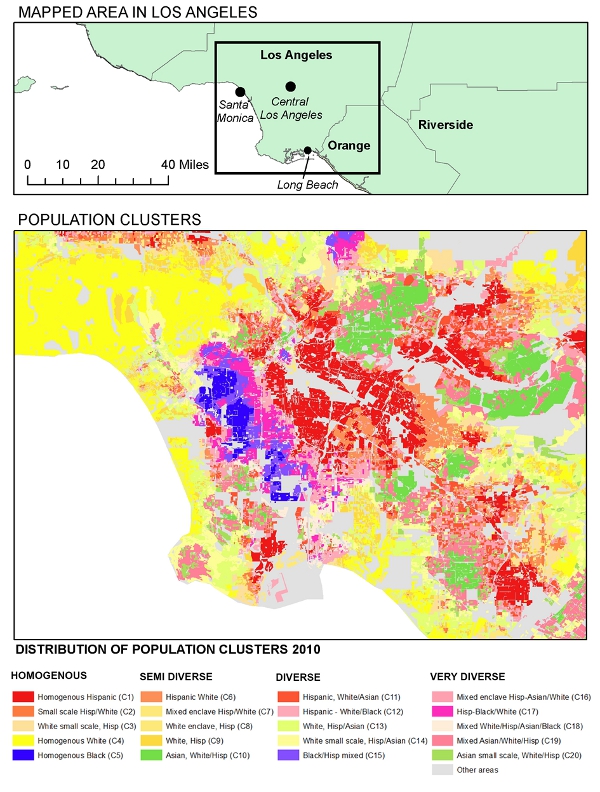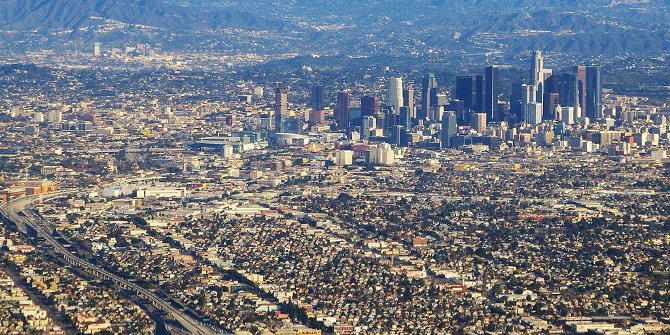 The makeup of American communities is changing – some communities are becoming more diverse, whilst others are becoming more segregated. In new research, William A.V. Clark, Eva Andersson, John Osth and Bo Malmberg examine trends in neighborhood diversity in Los Angeles since 2000. They find that only one third of people now live in strongly segregated neighborhoods, down from 40 percent in 2010, and that this increasing diversity has mainly been driven by the decline of homogenous white and black neighborhoods.
The makeup of American communities is changing – some communities are becoming more diverse, whilst others are becoming more segregated. In new research, William A.V. Clark, Eva Andersson, John Osth and Bo Malmberg examine trends in neighborhood diversity in Los Angeles since 2000. They find that only one third of people now live in strongly segregated neighborhoods, down from 40 percent in 2010, and that this increasing diversity has mainly been driven by the decline of homogenous white and black neighborhoods.
In 2000, about 40 percent of the population in Los Angeles lived in strongly segregated neighborhoods. Ten years later, in 2010, only a third of the population was still living in such neighborhoods. This trend towards increasing diversity is further strengthened by a lack of demographic stability in Los Angeles’ neighborhoods. Almost every other inhabitant lives in a neighborhood that has experienced significant shifts in the ethno-racial composition of its population during the last decade and a half.
These are the conclusions of our recent study that uses advanced geo-computational software, EquiPop, to analyze the demographic compositions of the neighborhoods for every individual living in the Los Angeles area in 2000 and 2010. Equipop creates neighborhoods by expanding a buffer around a given location until it encompasses the nearest hundreds, thousands, or tens of thousands neighbors and then computes the demographic composition of the buffer population. This allows a more exact measurement of each individual’s geographical context, and it also allows a classification of neighborhoods that is based on not a single geographical scale but sensitive to shifts in the population composition of both an individual’s immediate neighbors as well as the ethno-racial mix of distant neighbors. The approach is based on the idea that the extent to which individuals encounter members from different racial, ethnic, or socio-economic groups in everyday life is influenced by the patterns of segregation at multiple geographical scales.
Using this approach we have identified 20 different neighborhood types in the Los Angeles area ranging from strongly homogenous neighborhoods dominated by either black, white, Hispanic or Asian populations to highly diverse neighborhoods with close to equal shares of the different ethno-racial groups, see Figure 1 and Figure 2. The same classification has been used on both 2000 and 2010 census data and this has allowed us analyze the dynamics of neighborhood change over this period.
Figure 1 – Graphs showing the racial composition across multiple spatial scales of the neighborhood population for 20 different neighborhood types identified in the Los Angeles areas in 2000 and 2010 (click to enlarge)
Note: Neighborhood scales range from encompassing the closest 12 to the closest 51,200 neighbors. The graphs have been order from the least diverse (top row) to the most diverse (bottom row) in terms of racial composition. In each row the share of Hispanics decline and the share of whites increase from the first to the fourth column. Neighborhood types where blacks or Asians constitute the largest groups are in the fifth column.
Figure 2 – Population Diversity in the Los Angeles Metropolitan Area

The most important shift in the Los Angeles area is the decline of homogenous white neighborhoods. In 2000, 32 percent of all whites lived in such neighborhoods. In 2010, this share has declined to 21 percent. Also homogenous black neighborhoods have experienced a similar decline. In 2000, 15 percent of the black population living in homogenous black neighborhoods. In 2010 the share has declined to 11 percent. Homogenous Hispanic neighborhoods, in contrast, maintain their share of the Hispanic population, 33 percent in 2010, up from 31 percent in 2000. And Asians increasingly live in Asian dominated areas, 18 percent in 2010, up from 12 percent in 2000.
Increasing diversity in Los Angeles has mainly been driven by the decline of homogenous white neighborhoods and to some extent a similar decline in homogenous black neighborhoods. Thus, neighborhoods that have lost their white homogenous status between 2000 and 2010 have become increasingly diverse gaining significant population shares of mainly Hispanics and to some extent Asians. Neighborhoods that have lost their black homogenous status since 2000 have become black/Hispanic mixed neighborhoods in 2010. But changing status is not restricted to these neighborhood types. The increase in homogenous Hispanic neighborhoods is not only a result of increasing shares of Hispanics in formerly mixed areas. It is also a result of increases in the Hispanic population and a decrease in the white population around earlier small small-scale concentrations of Hispanics. A similar pattern can be seen with respect to the increase in Asian dominated areas. Dynamic diversity, that is changing neighborhood ethno-racial status over time, is even a stronger characteristic among neighborhoods with some degree of mixing in both 2000 and 2010. In these neighborhood categories it is almost as if changing neighborhood status is the rule, unchanged neighborhood status the exception.
By looking at the scale of interaction from the very local to the larger community we are getting closer to understanding what people do and who they are likely to meet in the city. The old administrative unit approach to segregation does not recognize the complexity of the modern world and that the probability of meeting another person who is different varies with the lens of examination. There is substantial mixing in Los Angeles and this is merely an example of what is happening in large multi ethnic cities in North America. It reflects the need to provide a more nuanced way of capturing the extent to which populations are likely to interact. There are decreasing areas of homogeneous populations and a rapid increase in areas which are a mixture of all the racial and ethnic groups. Diversity and heterogeneity is the new structure of urban society.
Our research also shows the strength of multi-scalar measures of neighborhood demographic composition. With this approach it becomes possible to analyze the dynamics of neighborhood change in a more detailed way than ever before and also with a tool that better captures the experience of living in diverse metropolitan areas undergoing rapid change.
This article is based on the paper, ‘A Multiscalar Analysis of Neighborhood Composition in Los Angeles, 2000–2010: A Location-Based Approach to Segregation and Diversity’, in the Annals of the Association of American Geographers.
Featured image credit: Ron Reiring (Flickr, CC-BY-2.0)
Please read our comments policy before commenting.
Note: This article gives the views of the author, and not the position of USAPP – American Politics and Policy, nor the London School of Economics.
Shortened URL for this post: http://bit.ly/1LLKFhd
_________________________________
 William A.V. Clark – University of California, Los Angeles
William A.V. Clark – University of California, Los Angeles
William A.V. Clark is a Professor with research interests in urban geography, spatial demography, and statistics. Professor Clark teaches courses in ethnicity, populations, and California.
 Eva Andersson – Stockholm University, Sweden
Eva Andersson – Stockholm University, Sweden
Evan Andersson is an Associate Professor in Human Geography at Stockholm University. The main themes of her research are residential segregation and neighborhood effects on socio-economic careers.
 John Osth – Uppsala University, Sweden
John Osth – Uppsala University, Sweden
John Osth is a Senior Lecturer in Geography and GIS at Uppsala University. His primary research interests are oriented towards Spatial Analysis and GIS software development and quantitative analysis in population, economic geography with a special focus on demography and migration, school choice and labor market opportunities, and the geography of human interaction on the Internet and through mobile phone usage.
 Bo Malmberg – Stockholm University, Sweden
Bo Malmberg – Stockholm University, Sweden
Bo Malmberg is a professor at the Department of Geography of Stockholm University. His years of research cover four different subfields of Human geography: Economic geography; Population geography; Urban geography, with focus on residential segregation and neighbourhood effects; and, finally GIS and remote sensing.





Just because there is ethnic racial diversity in formerly segregated neighborhoods is not the issue. The issue is whether they are blighted by poverty and substandard education. That matters because boomers are aging and a majority of pupils in public schools are now poor!